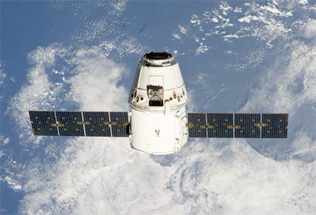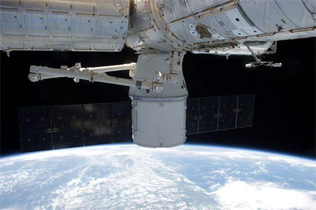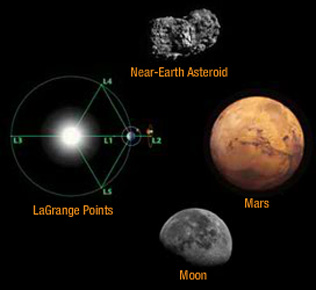On the 7th of October, 2012, SpaceX will fulfill its first contractual commercial resupply mission to the International Space Station on behalf of NASA.
Details of SpaceX CRS-1 Mission
USA: Time of Launch 8:34pm EDT, Oct 7
AUS: Time of Launch 10:34am EST, Oct 8
**Mission details measured in time relative to launch time.
———————————————————————
Day 1: LAUNCH
COUNTDOWN

A SpaceX Falcon 9 ready for launch (image source: SpaceX)
Hour/Min/Sec Events
– 7:30:30 Vehicles are powered on
– 3:50:00 Commence loading liquid oxygen (LOX)
– 3:40:00 Commence loading RP-1 (rocket grade kerosene)
– 3:15:00 LOX and RP-1 loading complete
– 0:10:00 Falcon 9 and Dragon terminal count autosequence started
– 0:02:30 SpaceX Launch Director verifies go for launch
– 0:02:00 Range Control Officer (USAF) verifies range is go for launch
– 0:01:00 Command flight computer to begin final prelaunch checks. Turn on pad deck and Niagara water
– 0:00:40 Pressurize propellant tanks
– 0:00:03 Engine controller commands engine ignition sequence to start
@ 0:00:00 Falcon 9 launch
LAUNCH

A SpaceX Falcon 9 launching (image source: SpaceX)
Hour/Min/Sec Events
0:01:25 Max Q (moment of peak mechanical stress on the rocket)
0:03:00 1st stage engine shutdown/main engine cutoff (MECO)
0:03:05 1st and 2nd stages separate
0:03:12 2nd stage engine starts
0:03:52 Dragon nose cone jettisoned
0:09:11 2nd stage engine cutoff (SECO)
0:09:46 Dragon separates from 2nd stage
DRAGON ON-ORBIT OPERATIONS IN THE FAR FIELD

A SpaceX Dragon module with solar panel arrays deployed (image source: SpaceX)
Hour/Min/Sec Events
0:11:45 Start sequence to deploy solar arrays
2:26:49 Start GNC (guidance and navigation control) bay door deployment—this door holds sensors necessary for rendezvous
———————————————————————
Day 2: DRAGON PHASING – DRAGON BEGINS APPROACH TO SPACE STATION

The International Space Station, destination for SpaceX’s commercial resupply contract (image source: SpaceX)
• Coelliptic burn places Dragon in a circular orbit
———————————————————————
Day 3: HEIGHT ADJUST MANEUVERS TO R-BAR AND CAPTURE

A Dragon module docked to the International Space Station in May, 2012 (image source: SpaceX)
(R-Bar – Radial Bar – is an imaginary line connecting station to the center of the Earth)
• Height adjust burns start adjusting altitude higher toward station
• COTS Ultra-high Frequency Communication Unit (CUCU) and on-board UHF communication system between Dragon and ISS is configured
• Height adjust burn: Dragon begins burns that bring it within 2.5 km of station (go/no-go)
• Dragon receives and sends information from/to the CUCU unit on station
• Height adjust burn brings Dragon 1.2 km from station (go/no-go)
• Height adjust burn carries Dragon into the station’s approach ellipsoid (go/no-go)
• Dragon holds at 250 meters (go/no-go) for confirmation of proximity sensors targeting acquisition
• Dragon begins R-Bar Approach
• Dragon holds at 30 meters (go/no-go)
• Dragon holds at capture point, 10 meters below the station (go/no-go)
• Crew captures Dragon using the station’s robotic arm (SSRMS)
• Dragon is attached to the station
———————————————————————
Day 4: HATCH OPENING
• Hatch is opened
RETURN DAY -1
• Hatch is closed
• Dragon vestibule de-mate and depressurization
RETURN

A SpaceX Dragon module in ocean after reentry in May, 2012 (image source: SpaceX)
• Station’s robotic arm uninstalls Dragon
• Robotic arm releases Dragon
• Crew commands the departure
• Dragon starts departure burns
• Dragon closes the guidance, navigation, and control bay door
• Deorbit burn
• Trunk jettisoned
• Drogue chutes deployed
• Main chutes deployed
• Dragon lands in water and is recovered








